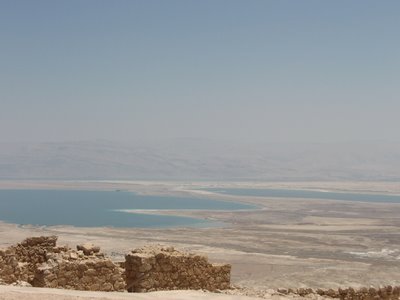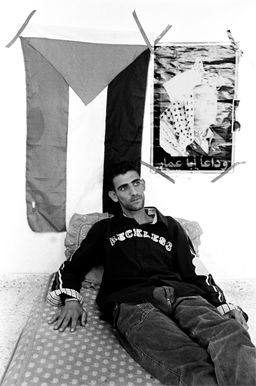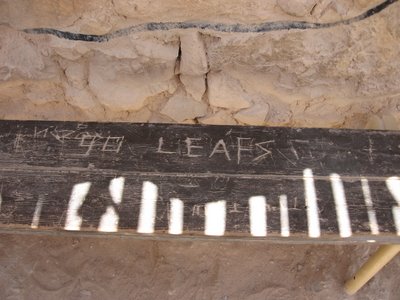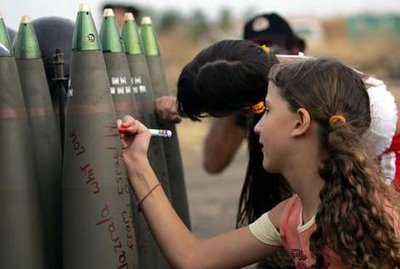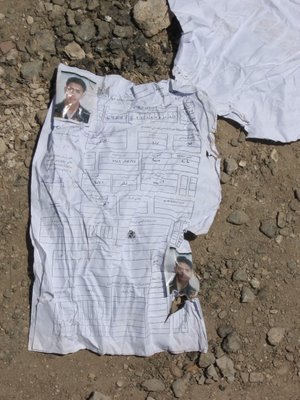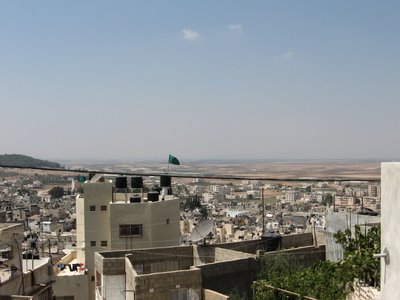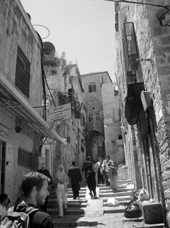Now that I'm half way through it I realize that this is one of the crazier things I've done. I'm sitting in a bus. A large air-conditioned coach... alone. The bus itself is huge with spots for 50 people and it feels so strange to be in it alone. We're idling on the Israeli side of the King Hussein/Allenby Bridge.
I'm on my way to Amman - the capital of the "Hasemite Kingdom of Jordan"- where I will later make my way to Petra. I knew that I wanted to take this border crossing because of the historical importance of the location since before I came to Palestine. I (should have known it would be particularly difficult when I had to get my visa in Canada before I came here - unlike the other two Israel-Jordan border crossings where you can get the Jordanian visa when you show up there. The issue is that the Jordanians don't actually consider it an international border crossing like they do the other two points which cross into Israel and not the Occupied Territories. This made for a difficult experience.
I start my journey after my last Arabic exam. Its just before noon on Monday; first to Ramallah. then to Jericho. Outside of Jericho my servees is stopped at a checkpoint where I nearly die of suffocation in the windowless back seat of the stretch Mercedes. It's nearly 50 degrees outside in one of the hottest towns in the Middle East. All I can think of is Ghassan Kanafani's novella Men in the Sun. "Those poor bastards" I think to myself. Finally at the checkpoint the soldier, my passport in hand, calls out to me: "Mark?" Yes "Where are you going?" Jericho (this is the entrance to Jericho - he must have thought I was in the wrong place) "Are you Jewish?" (He must have thought I was REALLY in the wrong place!).
I make it into Jericho soon thereafter and have a hard time figuring out how to get to the Bridge. One of the (many) flaws in my Arabic is that I can say what I want fairly easily but can't understand the rapid-fire responses that I get. Frustrating. So I take it a Cabbie first tell me that we need to go (back) down the road that I just came from. Im not interested in going back through the checkpoint and ask if there is another way.
He takes me in the opposite direction for 5 minutes when we come to a gated checkpoint. "Ask the soldiers if we can cross" he tell me. I tentatively approach the gate and make my way under the security bar and up to the group of soldiers. The first doesn't speak English and passes my case off to a colleague who does. "Where are you going?" he asks jovially - apparently a random white guy in this place at this time is somehow comical - I can see it I guess. "I'm trying to cross the bridge". He laughs again and says "Ok you can cross".
I jog back to my cabbie and pay him. The soldier wants me to hitch a ride in the back of a tour bus that is going through the checkpoint while I am there. Holding on for dear life, I stood in the back of a an air-conditioned (thank God!) bus filled with Arab-American tourists as it wound its way through dunes and trenches. We approached an intersection and it dawned on me that the only way to really get to the Allenby Bridge is along a settler road - or through the gated checkpoint - the reason that soldier was laughing is that he must have assumed I got lost - or assumed that I had thought that the only way to cross the bridge was going through Jericho. The regular way to cross the bridge, I suddenly understand, is not through Jericho but through the Jerusalem on-ramps to the settler road that bisects the West Bank - the same road my friends and I took to Masada and Ein Gedi a week ago. That's why my cabbie first wanted to take me back in the direction I had come - he wanted to take me back to Jerusalem.
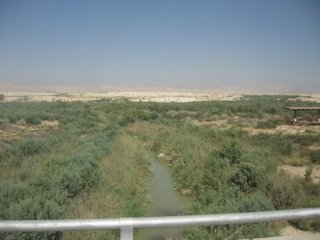 I arrived at the terminal after what was really a ten minute ride. I got off the bus and followed the passengers through two rounds of metal detectors and into a crowded and loud terminal before I'm told by the Israeli at the second security station that I'm in the wrong terminal. It seems I ended up in the Arab terminal when I should have been in the non-Arab (ie. White) building. He politely showed me to a set of double doors where I walked into a large open room. I'm was suddenly alone and I wandered up towards one of the three Passport control booths. The young pretty girl behind the glass (only one of the booths was occupied) pointed me back to another counter at the side of the room where I paid my $40 departure fee. Back at the booth I expected a hassle but didn't even get a question rom her. She looked at my passport, chatted with another young girl colleague who joined her in the booth (apparently someone actually using this terminal draws attention) stamp, stamp, smile, and I was through into a smaller waiting area. There were about a half dozen others waiting on the modular, molded plastic benches. Five minutes later and the passport girl had replaced a colleague at the One-Last-Needless-Documents-Check-Desk. I scanned the room blankly before I asked her: "How do I get to the bridge?"
I arrived at the terminal after what was really a ten minute ride. I got off the bus and followed the passengers through two rounds of metal detectors and into a crowded and loud terminal before I'm told by the Israeli at the second security station that I'm in the wrong terminal. It seems I ended up in the Arab terminal when I should have been in the non-Arab (ie. White) building. He politely showed me to a set of double doors where I walked into a large open room. I'm was suddenly alone and I wandered up towards one of the three Passport control booths. The young pretty girl behind the glass (only one of the booths was occupied) pointed me back to another counter at the side of the room where I paid my $40 departure fee. Back at the booth I expected a hassle but didn't even get a question rom her. She looked at my passport, chatted with another young girl colleague who joined her in the booth (apparently someone actually using this terminal draws attention) stamp, stamp, smile, and I was through into a smaller waiting area. There were about a half dozen others waiting on the modular, molded plastic benches. Five minutes later and the passport girl had replaced a colleague at the One-Last-Needless-Documents-Check-Desk. I scanned the room blankly before I asked her: "How do I get to the bridge?"
Surprised by the question she called to one of the staffers who told me that I'd have to wait 10-20 minutes. So I waited, and the others were lead onto a bus - "but not you (me)" - said one of the drivers. After a half hour - some of it slightly panic filled - I was finally told by another teenage girl that I could get on the bus that had just pulled up.
So now I'm on the bus, alone, in the "No-Mans" land between Israel and Jordan.
***
 I'm taken across in this giant tour bus, just me and the driver. We chat in Arabic until he starts asking me about something to do with money and a store at which point I tell him I don't understand (I don't) and eventually he desists. I think he was asking me to do something for him and then didn't believe me that I didn't understand him, thinking that I was trying to get out of doing this money-store thing for him. So we continued on in silence. Then he charges me 2 and a 1/2 dinar when we get to the Jordanian side. I know that he's ripping me off (the "2 dinar... no... 2 and a half dinar!" was a dead give away) but I'm so happy to be out of international limbo that I pay up without a much of a complaint.
I'm taken across in this giant tour bus, just me and the driver. We chat in Arabic until he starts asking me about something to do with money and a store at which point I tell him I don't understand (I don't) and eventually he desists. I think he was asking me to do something for him and then didn't believe me that I didn't understand him, thinking that I was trying to get out of doing this money-store thing for him. So we continued on in silence. Then he charges me 2 and a 1/2 dinar when we get to the Jordanian side. I know that he's ripping me off (the "2 dinar... no... 2 and a half dinar!" was a dead give away) but I'm so happy to be out of international limbo that I pay up without a much of a complaint.
The bridge itself was a bit of a let-down. Not 30m long it crosses a meek stream-of-a-Jordan River before ending back up in the desert. In the Jordanian terminal both passport officers (not the young pretty girls you find in Israel!) are smoking. I love it - it reminds me of the border between Chile and Argentina, in the middle of the Andes, where the border control guards chain smoke and drop ashes in your passport.
He asks me if I have a visa - I do - and with the help of the tourist police I make my way to a bus that (I hope) is going to Amman.
***
Pictures:
King Hussein and King Abdallah II welcome you to Jordan
The Jordan River from the Allenby Bridge
The Allenby Bridge





